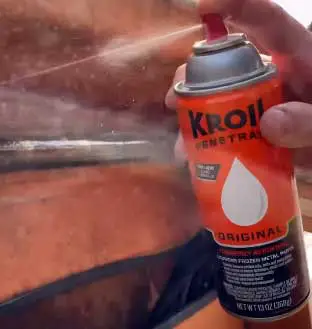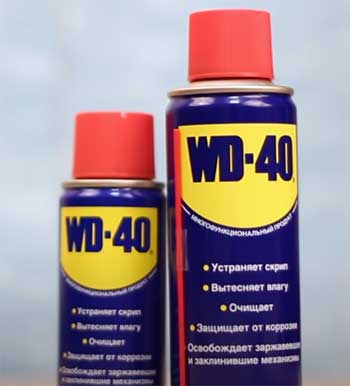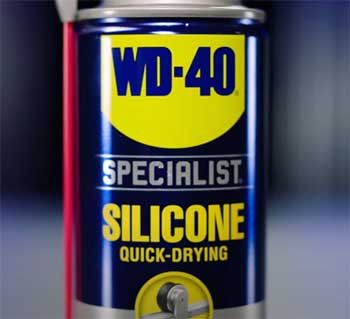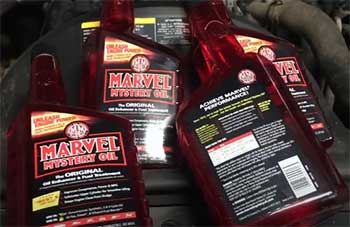Penetrating oils are a must-have for any toolbox or garage. When nuts, bolts, or parts get stuck due to rust or corrosion, a good penetrating oil can be a lifesaver. Two of the most popular and well-known penetrating oils on the market are Kroil and WD-40.
But which one is better?
This comprehensive guide will compare Kroil and WD-40 head-to-head, looking at performance, ingredients, uses, and more to help you decide which penetrating oil is right for your needs.
A Brief Comparison Table
| Aspects | Kroil | WD-40 |
| Formula | Proprietary blend of capillary solvents | Mineral spirits, petroleum distillates, oils |
| Penetrating Ability | Excellent, flows quickly into microscopic spaces | Moderate, gradual penetration |
| Speed | Extremely fast acting, works in seconds/minutes | Slower acting, needs prolonged time to penetrate |
| Odor | Very strong solvent smell | Strong petroleum odor |
| Uses | Freeing stuck parts and precision equipment | Surface rust removal, lubricating, moisture displacement |
| Safety | Can damage some plastics/coatings if overapplied | Considered safe for most household uses |
| Price | $10-$20 per bottle, expensive | $5-$10 per can, budget friendly |
| Best For | Severely seized and stuck bolts/parts | General lubrication and rust prevention |
Kroil Penetrating Oil

Kroil is a specialty penetrating oil that has been around since the 1920s.
It was originally developed byuren Frank Kroil in his basement workshop to loosen stuck drill pipe collars in the oil fields of Pennsylvania.
The unique lightweight formula proved so effective that it quickly gained a following among oil field workers and mechanics.
Kroil continues to be produced by Kano Laboratories, using Frank Kroil’s original solvent blend recipe.
Here are some key facts about Kroil:
- Formula: Proprietary blend of light oils and solvents
- Performance: Unrivaled at penetrating into microscopic spaces and seeping between stuck parts. Super fast acting.
- Uses: Freeing stuck bolts, nuts, locks, hinges, tools, engines, industrial equipment. Displacing moisture. Lubricating precision parts.
- Pros: Extremely effective, fast acting, versatile formula. Does not contain silicones, CFCs or known carcinogens.
- Cons: More expensive than other penetrating oils. Strong odor. Can damage plastic and painted surfaces if overapplied.
Kroil’s unique capillary action allows it to wick and spread through the tiniest spaces between stuck parts. Users report it working in seconds to minutes on stubborn frozen bolts and parts that resisted hours of effort with other products.
The thin, fast-penetrating formula is perfect for precision parts like firearms, instruments, locks, hinges, and small engine carburetors.
The active solvents in Kroil break the bonds of rust and corrosion while also lubricating the mechanisms. It can be used for moisture displacement as a short-term protectant on tools and equipment. The oil creeps along metal surfaces and leaves a lubricating film that enhances glide and smooth operation.
Just a few drops or sprays of Kroil can penetrate deep into stuck parts. The product is made in the USA and comes in both aerosol spray and liquid dropper bottles.
WD-40 Penetrating Oil
WD-40 is likely the most recognizable penetrating oil in the world. The product began as a rocket fuel component called “Water Displacement perfected 40 tries” in 1953 and was later marketed as the go-to product for loosening stuck parts and tools.
WD-40 is manufactured by the WD-40 company and sold worldwide as a multi-use oil and lubricant.
Here are the main details on WD-40:

- Formula: Mineral spirits, petroleum distillates, oils, lubricants
- Performance: Moderate penetrating ability. General purpose lubrication.
- Uses: Surface rust removal, moisture/grease displacement, lubricating hinges, tools, chains, wires
- Pros: Readily available, affordable, versatile. Safe on many surfaces.
- Cons: Not as fast/powerful on seized bolts. Higher solvent odor.
WD-40 relies more on lightweight mineral spirits rather than capillary solvents to get between stuck surfaces.
It can help penetrate rust and lubricate parts, but often needs to soak for a longer time compared to more potent formulas.
WD-40 also contains a high percentage of lubricating agents along with the solvents.
This makes it a good generalist product – able to wear down rust while also leaving an oily lubricating film behind.
WD-40 protects metal against moisture and future corrosion. The petroleum distillates help displace water, grease and grime.
The familiar blue and yellow can of WD-40 is widely available at hardware and automotive stores for just a few dollars. It’s a good budget-friendly penetrating oil for handling various household jobs like squeaky hinges, tools, bicycle chains, small stuck bolts and more.
Kroil And WD-40 Head-to-Head Comparison
Now let’s directly compare some key factors between Kroil and WD-40:
Penetrating ability
- Kroil has vastly superior penetrating power thanks to its blend of quick-flowing solvents that seep deeply into spaces. It spreads faster and works quicker than WD-40.
- WD-40 has moderate penetrating ability from the mineral spirits. It can work with longer application but may struggle on tighter, more seized parts.
Speed
- Kroil goes to work extremely fast, penetrating and loosening stuck bolts in seconds or minutes in many cases. Its capillary action is unmatched.
- WD-40 can take hours or days of application to deeply penetrate stuck parts. Its performance is gradual rather than fast-blasting.
Formulas
- Kroil relies mainly on a proprietary blend of capillary solvents to penetrate and dissolve gunk.
- WD-40 contains a higher percentage of lubricating ingredients along with light solvents.
Odor
- Both products have strong solvent odors, with Kroil’s likely being more potent due to the active ingredients.
Safety
- WD-40 is widely regarded as safe for use on most tools, surfaces, and parts. Avoid plastic.
- Kroil is very powerful and can damage some plastics, paints and coatings with overapplication.
Also Read: Differences Between Kroil And PB Blaster Penetrating Oils.
Price
- Kroil costs around $10-20 for a medium sized can, putting it at the higher end for penetrating oils.
- WD-40 can be purchased for just a few dollars per can, making it the budget friendly option.
Users
- Kroil is hugely popular among professional tradesmen, mechanics, and industrial workers for its sheer power.
- WD-40 is used by everyone from DIYers to professionals as an affordable, generalist lubricant-solver.
So when should you use Kroil versus WD-40? Here are some recommendations:
- For super-stubborn seized bolts/parts, turn to Kroil for its unrivaled penetrating power.
- For an all-purpose lubricant for hinges, wires, tools, etc. WD-40 gets the job done.
- For quickly freeing stuck guns, instruments, carburetors, Kroil’s precision formula works best.
- For a budget-friendly option safe for many surfaces, WD-40 fits the bill.
- For long-term rust prevention and general lubrication, WD-40 leaves a protective coating.
- For sheer speed penetrating tight spaces, nothing beats a few drops of Kroil.
Both Kroil and WD-40 will work to free stuck parts with enough time and elbow grease. Kroil just has a great advantage in cutting that time dramatically. Its calibrated capillary solvents are engineered to penetrate faster and deeper.
The trade-off is higher cost and potential to damage some materials if misused.
WD-40 is the more versatile, beginner-friendly option suitable for a range of household tasks. But for the professionals who need to get the job done without waiting, Kroil is often worth the premium price tag.
Understanding these key differences allows you to choose the right penetrating oil for your specific needs.
Other Penetrating Oils
Beyond Kroil and WD-40, there are other penetrating lubricant options on the market that may suit specific needs:
- PB Blaster – Another popular penetrant using petroleum, mineral spirits and oils. Good at breaking down rust.
- Liquid Wrench – Contains more lubricant additives than WD-40. Used on stuck bolts, cars, bicycles.
- Aerokroil – Similar fast capillary action as Kroil. Used by aviation industry.
- Marvel Mystery Oil – Multi-use with moderate solvency and added engine lubricants.
- SeaFoam Deep Creep – Specialty penetrant focused on sea and marine equipment.
- Kano Kroil Penetrating Oil – Kano Lab’s original classic Kroil formula with amazing penetrating speed.
- 3-IN-ONE Professional Penetrating Oil – Budget-friendly option that works for light jobs.
Most hardware or automotive stores will carry an assortment of penetrating lubricant products beyond just WD-40. Browse the options to find one suited for your specific job.
The heavier, professional-grade formulas offer better performance but cost more. Light oils suffice for simple jobs and household use.
When To Avoid Penetrating Oils?
While penetrating oils can provide some much-needed lubrication and rust-busting power, there are certain situations where they should be avoided:

- On plastic, painted or delicate surfaces – Ingredients may damage or dissolve surface coatings.
- Inside electronic equipment – Can leave a gummy oily residue on circuits and components.
- On firearms actions – May degrade firing pin channel lubrication over time.
- As a long-term lubricant/protectant – Does not last as long as dedicated oils and greases.
- Around food prep areas – Can contaminate food due to high solvent content.
It’s always smart to check product instructions and do a small test patch before spraying penetrating oils near any sensitive components or materials.
While designed to penetrate small crevices, they can spread widely and stain or harm surfaces if overapplied.
Using Penetrating Oils Effectively
To get the most from Kroil, WD-40 or any penetrating oil, follow these tips:
- Clean parts first to remove any gunk or grime blocking access to crevices.
- Apply liberally and let penetrate for 15-30 minutes before trying to work the part free. Reapply frequently for stubborn jobs.
- Use precision nozzles or straws included with cans to target tight spots. Avoid overspray.
- Tap or vibrate parts while oil penetrates to help it work deeper into spaces.
- Let excess oil drain off and consider a degreaser rinse if needed before reassembling lubricated parts.
Also Read: Comparison of WD-40 And Fogging Oil.
Frequently Asked Questions (FAQ)
For most mechanics and professionals, Kroil penetrating oil stands as the absolute best in class for freeing stuck parts. Its specialized formula has capillary action and solvent properties that are unmatched for speed and efficacy. A few sprays of Kroil can save hours of effort compared to ordinary oils.
Kroil owes its incredible penetrating performance to its proprietary blend of fast-wicking solvents that can spread into microscopic spaces. This capillary action combined with rust-dissolving ability lets Kroil quickly reach and release stuck parts. The exact formula is a trade secret but users attest Kroil outperforms the competition.
For a generalist, budget-friendly oil, WD-40 is hard to beat. But as a pure lubricant there are better options than WD-40, which relies more on solvents than slick oils. Dedicated lubricants like lithium grease, silicone spray, and PTFE oils will outperform WD-40, especially on moving parts. WD-40 does offer slight lubrication along with rust protection.
No other penetrating oils fully match the performance of Kroil, but Aerokroil and SeaFoam Deep Creep come the closest with their fast penetrating formulas tailored for aviation and marine. Kano Lab’s original Kroil remains the top oil thanks to its proprietary blend used exclusively in their products.
Closing Remarks
Applying penetrating oil properly lets it work most effectively while reducing mess and potential damage to nearby parts. Don’t expect oils to immediately break very tightened rust – penetrating takes patience.
But the right product makes the difference between an afternoon of rounding off bolts and a few minutes of smooth removal.

